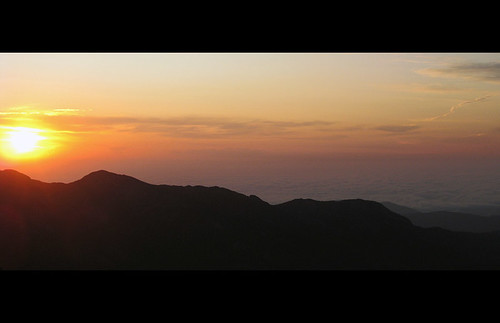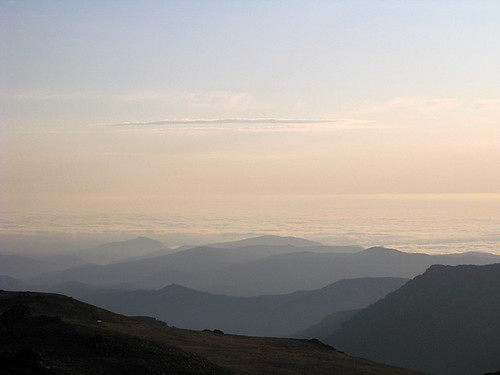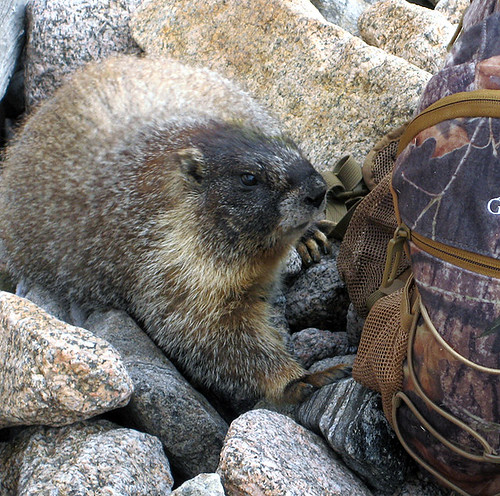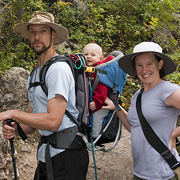Long’s Peak Summit Bid
Wow, almost the entire month of September has gone by, with only a single blog post. Sad. But, I have a little time now, and I wanted to post something about our “learning experience” on Long’s Peak in August.
We have lived in Colorado for more than five years now, and never set foot on the one 14’er that we can see from our house – Long’s Peak. And for several good reasons. The easiest route up the mountain is a class 3 climb, legendary for it’s exposure and pucker factor. The approach to said climb is more than 7 miles long, making a summit trip a 16 mile long hike. Add that to the fact that the route is usually only snow-free for about 8 weeks a year, and you get several summers of Mark and I putting off the climb.
This summer, I thought ahead and snagged campsite reservations in Rocky Mountain for the last weekend in August. As the time came near, the weather looked great, we had a very fun alpine climb earlier in the summer and decided to head up Long’s on a technical (roped climbing) route on the North Face.
We had a rough night of it Friday night, when we arrived at the campsite to find that I had left all of our sleeping gear (bags, pads, blankets and pillows) at home. We made the trip back to the Fort and then back to the park with the gear in about 3 hours, and crashed Friday night around midnight. Not going to be getting up at 3am to climb the next day. Instead, we spent Saturday doing a light, 6 mile hike up to Lake Helene and back.
Sunday morning we woke up at 2:30a, packed up our campsite, and were hiking up the Long’s trail by 3:30a. Six miles of hiking and 4,000ft of elevation gain later, we arrived at the Boulderfield backcountry campground at around 8:30a. And I was sick as a dog. I was dizzy, with a massive headache, nauseated and exhausted.
Mark left me to nap on top of the ropes (surrounded by giant marmots) for an hour or so while he hiked up to Chasm view, what would have been the start of our climb. He thought the spot was absolutely fantastic, and came back with a new found love of a mountain he had never really wanted to climb before.
We headed down just before noon, watching clouds gather for afternoon rainstorms, and without climbing or summiting Long’s. So, what happened? Here’s my take-away lessons from the day:
1. Even if I’m pretty fit and live at altitude, I can’t wake up one morning and decide to hike 16 miles with a 25 pound pack. Our longest approach this summer was probably only 2 miles long. I should have recognized my lack of hiking fitness.
2. I should not carry the same weight as Mark on long, high altitude hikes. I like to pretend that I’m an awesome, hard-core mountain climber that can “pull her own weight,” but the reality of the situation is that I weight 40 pounds less than Mark, and should not be carrying the same (or slightly more) weight in gear as he does. If my pack had weighed 10 pounds less, we might have succeeded that day.
3. Carry less water, eat more food. Because I felt I needed to save the food for later, I did not eat enough on the hike up. I also carried nearly 3 liters of water with me, which is not necessary. We have filter and could fill up from the creak that flows alongside the trail at any point. I could have shed some significant weight in my pack if I had just carried a single liter.
4. And finally, treat headaches before they become serious. I know this, and if I take Tylenol at the first sign of altitude headaches, I can go all day without much problem. But on Sunday, I decided to keep moving instead of stopping to dig pills out of my pack. Big mistake.
So, even though Mark thoroughly enjoyed his day romping across the slopes of the highest peak in RoMo, I was disappointed, sick, and in huge pain by the time we made it back to the car. Maybe next year I’ll get in some training, and finally succeed on this beautiful climb.








3 Comments